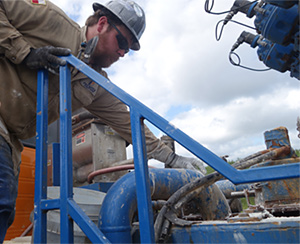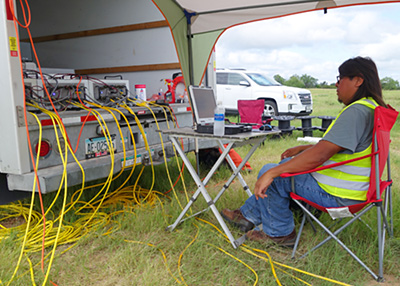
Technicians inject specialized EM contrast agents into the injection well to enable remote fracture network mapping at the Devine test site.
Just as a spider web looks different when observed from a number of angles and in various lighting, so, too, will the fractures resulting from a hydraulic fracturing operation appear when measured with different instruments and from numerous angles. “You have to look at the fracture pattern with the right set of eyes,” said Mohsen Ahmadian, Advanced Energy Consortium (AEC) project manager. “Our hope is to better determine where exactly the fractures have gone after a hydraulic fracturing job to help maximize hydrocarbon production from those fractured rock formations.”
For many years, the AEC has brought researchers from institutions around the world together to investigate nanotechnology methods for illuminating the subsurface using various types of contrast agents—some applicable to electromagnetic (EM) geophysics, others using seismic tooling, and still others incorporating tiny autonomous electronic downhole sensors. Several of these technologies were demonstrated at lab scale and in shallow field-scale tests last year and are now ready for demonstration under more reservoir-like conditions.

AEC researchers are conducting electromagnetic (EM) measurements to study the utility of injected EM contrast agents for remote fracture network mapping.
Recently, the AEC conducted an extensive subsurface experiment at the Bureau’s Devine Test Site, southwest of San Antonio, Texas. Test wells were drilled around a central injection well, which was hydraulically fractured. The AEC’s EM contrast-agent material was injected into the formation to illuminate the fracture pattern using geophysical tools that are used by industry. The data, still under analysis, look promising.
“Following interpretation of results, we will validate our EM model predictions by coring the fractured interval and compare the EM test results to other geophysical techniques that were included in the Devine experiment.” Ahmadian reports. “AEC researchers have worked with us and our industry partners over the years to develop this innovative EM mapping approach, and this experiment at Devine has gone a long way toward proving the viability and importance of this work.”
For more information about the Advanced Energy Consortium or to become a partner in its research, contact Jay Kipper, Bureau associate director.